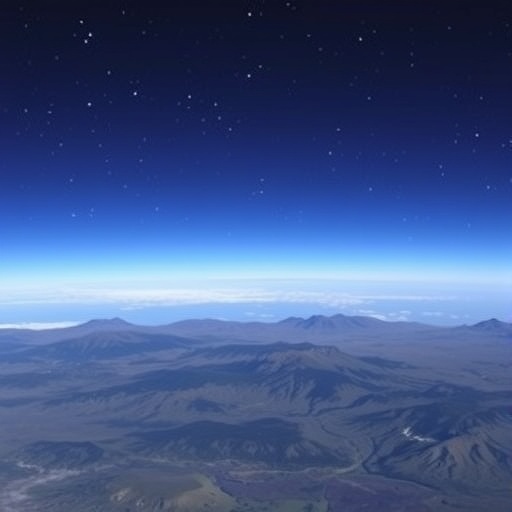The field of astrophysics is continuously evolving, with significant advancements being made in the study of cosmic phenomena through various observational methods. One particularly promising avenue of research is the use of ground-based millimeter and sub-millimeter Very Long Baseline Interferometry (VLBI) arrays. These arrays allow researchers to examine celestial objects with unprecedented resolution and sensitivity. The recent work by Ayzenberg, Blackburn, Brito, and their colleagues sheds light on the fundamental physics opportunities that can be unlocked by these future observational facilities, pushing the boundaries of our understanding of the universe.
The primary advantage of ground-based mm/sub-mm VLBI arrays lies in their ability to observe astronomical phenomena at incredibly high angular resolutions. The precision achievable by these arrays rivals that of space telescopes, while benefiting from the larger apertures made possible by combining signals from multiple terrestrial observatories. This synergy not only enhances resolution, enabling the detailed study of phenomena such as black holes and neutron stars, but also boosts sensitivity to faint celestial signals. Such advancements promise to provide new insights into physical processes that govern the universe.
One area where ground-based VLBI arrays might lead to groundbreaking discoveries is in the study of black hole physics. As researchers focus on the Event Horizon Telescope’s recent image of the black hole at the center of the Milky Way, the potential of millimeter and sub-millimeter astronomy becomes clear. Future VLBI arrays will allow for even more detailed imaging and tracking of accretion processes around these gravitational giants. Understanding these dynamics is crucial, not only for the physics of black holes but also for refining our general theories of relativity.
Additionally, ground-based mm/sub-mm VLBI arrays are expected to contribute significantly to the exploration of gravitational waves. The ability to detect and study their electromagnetic counterpart signals will enhance our understanding of cosmic phenomena resulting from massive events like neutron star mergers and black hole collisions. The observational capabilities afforded by these advanced arrays will help bridge the gap between gravitational wave astronomy and traditional electromagnetic observations, bringing a more holistic view to our understanding of the cosmos.
Another pivotal aspect where future VLBI arrays are set to impact fundamental physics is cosmology. The studies of the Cosmic Microwave Background (CMB) radiation at millimeter and sub-millimeter wavelengths will be transformed. Improved measurements of the CMB anisotropies will allow scientists to probe the early universe’s conditions more accurately than ever. By comparing these observations with predictions made by inflationary models, researchers can gain insights into the fundamental mechanisms that governed the birth of the universe.
The study of star formation processes is yet another frontier that stands to benefit from advances in mm/sub-mm VLBI technology. To truly understand how stars form and evolve, it’s vital to observe the surrounding material from the earliest stages of their development. Ground-based arrays will offer the sensitivity to capture data from distant, dusty regions where stars are born, thereby illuminating the intricate processes involved in stellar development. This could lead to a significant leap in our understanding of chemical enrichment in galaxies and the evolution of cosmic structures.
Moreover, the capabilities of these new arrays will extend to studying exoplanetary systems as well. Ground-based VLBI can dissect the faint signatures emitted from distant planetary systems, offering insights into their atmospheric compositions and the potential for habitability. As the quest for life beyond Earth intensifies, the ability to analyze distant worlds in such detail may ultimately reveal whether we are alone in the cosmos.
One cannot overlook the technological advancements that facilitate these ambitious endeavors. Enhanced receiver technologies, advanced signal processing techniques, and improved data handling capabilities will empower future VLBI networks. By interconnecting a broader range of observatories, the resulting array will achieve a level of performance unattainable with existing infrastructures. This interconnectedness will create a united front in the fight to understand the universe, pooling resources and data for a richer tapestry of cosmic insight.
As more observatories join in on this endeavor, researchers will also be able to create more sophisticated simulations of astrophysical phenomena. The detailed observational data captured by ground-based mm/sub-mm VLBI arrays will feed back into refining simulation models, leading to better predictions and enhanced understanding of complex processes. This iterative relationship between observation and theory is essential for the advancement of physics and astronomy.
One of the remarkable aspects of the future of ground-based VLBI arrays is their capacity for collaboration across the globe. By linking facilities from diverse geographical locations, these arrays will take advantage of the Earth’s rotation to achieve unprecedented levels of resolution. Furthermore, global partnerships among institutions and researchers ensure a wealth of knowledge and expertise is pooled together, driving innovation and discovery in the field of astrophysics.
In conclusion, the research spearheaded by Ayzenberg and colleagues serves as a beacon for the future of astrophysics. Ground-based millimeter and sub-millimeter VLBI arrays promise to revolutionize the way we observe the cosmos. From the study of black holes to the exploration of exoplanets, the implications are profound and far-reaching. As researchers lay the groundwork for this exciting new chapter in observational astronomy, the promise of unlocking some of the universe’s deepest secrets grows ever closer.
Each of these facets highlights the rich tapestry of possibilities opened up by the upcoming technologies in ground-based VLBI. As the planned observatories move towards realization, both scientists and enthusiasts alike eagerly await the revelatory discoveries that will surely emerge, forever changing our understanding of the cosmos and our place within it.
Subject of Research: Ground-based millimeter and sub-millimeter Very Long Baseline Interferometry arrays in astrophysics.
Article Title: Fundamental physics opportunities with future ground-based mm/sub-mm VLBI arrays.
Article References:
Ayzenberg, D., Blackburn, L., Brito, R. et al. Fundamental physics opportunities with future ground-based mm/sub-mm VLBI arrays.
Living Rev Relativ 28, 4 (2025). https://doi.org/10.1007/s41114-025-00057-0
Image Credits: AI Generated
DOI:
Keywords: VLBI, astrophysics, black holes, gravitational waves, cosmology, star formation, exoplanets.




